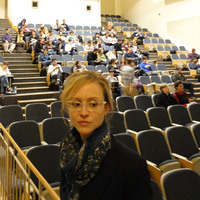In the CIT blog, we are highlighting the experiences of faculty in the 2013-14 Flipping the Classroom Fellowship. This program provided an opportunity for faculty from different disciplines to learn and share ideas about active learning techniques they could use in their own classrooms.
Two of the Fellows in the program discussed how they used active learning techniques in Humanities classes. While many Humanities classes use small seminars and active learning, Fellows took their teaching a step further, developing creative ways that students could apply what they have learned.
If you are interested in getting ideas to bring more active learning into your own class, contact the CIT to talk with a consultant.
Sandra Valnes Quammen
Lecturer, French; Assistant Director of the French Language Program
 The course that I teach is an accelerated elementary French course, in which students cover two semesters of elementary French in a single semester. In this course, we’ve moved away from a traditional elementary language textbook in favor of stand-alone materials as well as open-access elementary French materials. As with all courses in the French language program, students are required to work with the new grammar and vocabulary concepts on their own before coming to class, and so in this sense, our courses have always been flipped.
The course that I teach is an accelerated elementary French course, in which students cover two semesters of elementary French in a single semester. In this course, we’ve moved away from a traditional elementary language textbook in favor of stand-alone materials as well as open-access elementary French materials. As with all courses in the French language program, students are required to work with the new grammar and vocabulary concepts on their own before coming to class, and so in this sense, our courses have always been flipped.
This semester, however, my students are also engaged with native French speakers in Africa for a multi-part Skype-based exchange to practice their growing French knowledge in real-life situations. Students will wrap up their work in my class with a final project and presentation which requires them to tie their study of French into their major or other outside interests.
Amanda Starling Gould
PhD Candidate, Literature
 Augmenting Realities is a literary digital humanities writing course that teaches students multimodal approaches for reading, writing, and theorizing print, digital, and transmedia literary artifacts. One of the primary goals of this writing-attribute course, alongside improving writing skills and digital literacies, is to interrogate how media technologies and our various layers of ‘reality’ converge to alter our experience and understanding of contemporary life.
Augmenting Realities is a literary digital humanities writing course that teaches students multimodal approaches for reading, writing, and theorizing print, digital, and transmedia literary artifacts. One of the primary goals of this writing-attribute course, alongside improving writing skills and digital literacies, is to interrogate how media technologies and our various layers of ‘reality’ converge to alter our experience and understanding of contemporary life.
Unlike the typical research writing course, Augmenting Realities is deliberately designed to be a digital humanities course that purposefully and provocatively integrates digital tools into its critical apparatus and pedagogical method. In order to understand media technologies, we take a hands-on approach to make, hack, test, and tinker with media technologies. Borrowing a method best known to computer programmers, designers in labs, and artists/hackers working with material media, Augmenting Realities adopts a makerspace learning environment so as to faciliate experimentation and encourage critical-making. This course not only benefits from an innovative ‘flipped’ course structure but I’d argue indeed it demands it.
I wrote a blog post about our Flipping the Faculty Panel for HASTAC and I have a pedagogical article about my class and methods in the Spring 2014 special issue of The Humanities Education and Research Association (HERA) Journal Interdisciplinary Humanities. It was in part the support and encouragement of the Fellowship that gave me the confidence to pursue such a publication.

